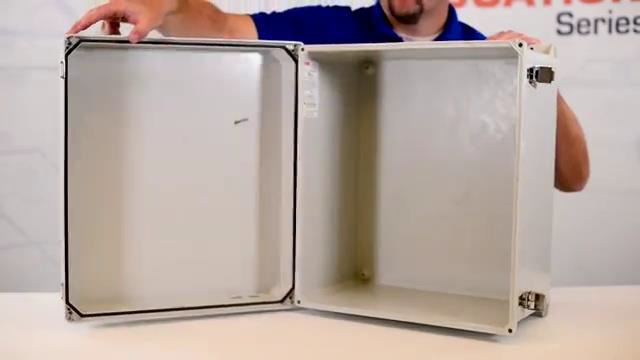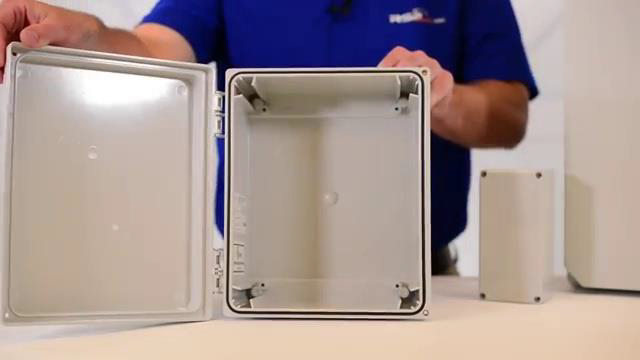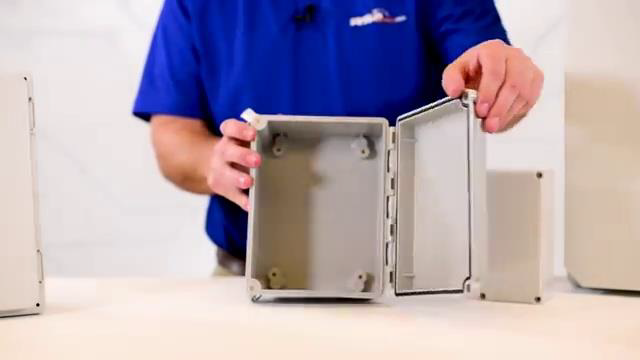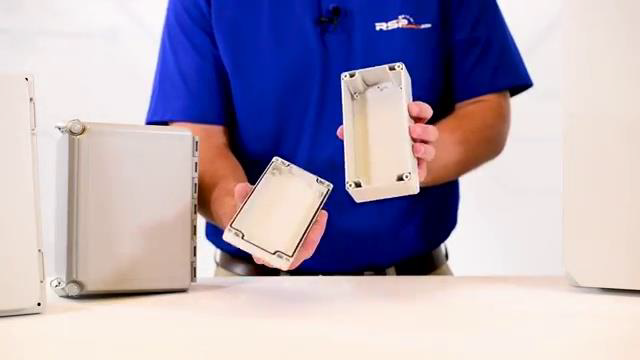Non_Metallic_Enclosure_Types.pdf
Non-Metallic Enclosures all:
- Have a NEMA 4x rating for - Chemical resistance - Outdoor Use - Protection from Dust and Air Debris - Protection from Water and Rain
- Have a High Insulation Value which - Insulates from cold and hot - Does Not Dissipate heat out from inside the enclosure
- Is not Conductive - Can’t be used for grounding components to the enclosure - Provide the same security and tamper resistance levels as metallic enclosures when properly locked.
Types of Non-Metallic Enclosures
- Fiberglass - A thermoset polyester material reinforced with glass fibers, is the most widely used non-metallic material in the industry - High impact strength and rigidity (dimensional stability) - High impact resistance - Superior working temperature range (-31˚F to 300˚F) - Excellent electrical properties - Excellent moisture and overall chemical resistance - Cost effective
- Polycarbonate - High-performance thermoplastic resin processed by injection molding or sheet extrusion - Good rigidity (dimensional stability) - Superior impact resistance - Extended temperature range (-31˚F to 180˚F) - Excellent electrical properties - Polycarbonate can offer superior fire retention and UV stability - Good corrosion resistance in some acidic surroundings - Not suitable for environments with strong alkalis and organic solvents - Low to moderate price
- ABS - ABS or ABS blends - High impact resistance - Less impact resistance in cold weather than polycarbonate - Excellent electrical properties - Superior chemical and moisture resistance - Narrower temperature range than fiberglass (-40˚F to 248˚F)
- Polyester - High-performance unfilled thermal plastic is processed using injection molding - High impact resistance - Less impact resistance in cold weather than polycarbonate - Excellent electrical properties - Superior chemical and moisture resistance - Narrower temperature range than fiberglass (-40˚F to 248˚F)
Transcript:
[0m:4s] Hi I'm Josh Bloom, welcome to another video in the RSP Supply education series. Today we're going to be talking to you about nonmetallic enclosures, the different types of enclosures, the advantages and disadvantages of each. First, let's talk about the common characteristics shared by most all nonmetallic enclosures. First and foremost, they are less expensive than a common metallic enclosure which can be a huge advantage. Secondly, they offer a 4X Nema rating which provides excellent resistance to corrosion and chemicals, slso dust and water resistance which makes them an excellent choice for outdoor use. They are very lightweight, easy to modify, they offer excellent insulation from solar heat absorption. They, however, do not dissipate the heat very well from any heat that might be created with inside the enclosure itself. They are non conductive so they cannot be used for grounding. They are very durable and long lasting enclosures. The first type of nonmetallic enclosure we want to talk to you about today is fiberglass. Fiberglass is the most common and probably most popular type of nonmetallic enclosure on the market today. Most fiberglass enclosures are made from polyester impregnated with glass fibers. They have excellent UV resistance, however, if exposed to the sun, they can dull and discolor over time, allowing the glass fibers to raise to the surface. This type of degradation is referred to as fiber bloom. Protective coatings can be applied to these enclosures to help reduce that degradation. Fiberglass enclosures are very rigid which allows them to be fabricated to much larger sizes than most other nonmetallic enclosures. They do have a very high impact strength. They offer excellent resistance to corrosion and chemicals. They are easier to modify than metallic enclosures, however the glass fibers can dull blades and drill bits. They do also offer a superior operating temperature range anywhere from negative 31 degrees Fahrenheit all the way up to 300 degrees Fahrenheit. The next type of nom metallic enclosure we want to talk about is polyester. Polyester is newer to the market and therefore it is not as common. It does, however, offer excellent UV protection, it's not subject to the same fiber Bloom problems such as fiberglass, and it can slightly dull or discolor, but again, not nearly as much as fiber glass. Polyester enclosures are not as rigid as fiberglass or metallic enclosures, so are typically not made larger than 36 inches.



[2m:27s] They do offer excellent impact strength,
[2m:29s] better than both fiberglass and metallic, they also offer excellent resistance to corrosion and chemicals. They are very lightweight, easy to modify and have an operating temperature range of negative 40 degrees Fahrenheit all the way up to 248 degrees Fahrenheit.
[2m:46s] The next type of nonmetallic enclosure we're going to talk about are polycarbonate enclosures. Polycarbonate are probably the second most common type of nonmetallic enclosure and are typically used for smaller applications.
[2m:57s] They do offer good UV resistance, however, not nearly as good as the polyester or fiberglass enclosures. In some cases, you may see glass reinforced polycarbonate enclosures to provide more stiffness for use in larger sizes. However, this is not going to be the best option for UV exposure. So, polycarbonate enclosures are not as rigid, much more flexible and therefore, are typically seen in smaller sizes.

[3m:21s] They do offer a very good impact strength surpassed only by polyester.
[3m:25s] They also offer good corrosion resistance and fair chemical resistance. They are very lightweight, easy to modify and have an operating temperature range of negative 30 degrees Fahrenheit up to 180 degrees Fahrenheit.
[3m:39s] The last type of non metallic enclosure we're going to talk about today is an ABS enclosure. APS is a lower cost option that can still offer many of the benefits that you might see from the higher priced options. However, it does not offer very good UV resistance and is recommended for indoor use, only.
[3m:56s] ABS enclosures are not very rigid and pretty flexible and are typically not seen in sizes larger than 18 inches. They do, however, have a very good impact strength.
[4m:6s] They do offer good corrosion and chemical resistance, they're very lightweight, again easy to modify, and have an operating temperature range of negative 40 degrees Fahrenheit all the way up to 248 degrees Fahrenheit.

[4m:18s] These are the main types of nonmetallic enclosures. With the advances in research and development and materials, they could be a great choice depending on the application.
[4m:26s] These are the main types of nonmetallic enclosures. With the advancements and research and development materials, they can be a great choice depending on application. They are a cost effective alternative to metallic enclosures, and in many cases can be a better choice than metallic enclosures depending on the situation. Be sure to look at the charts on our education page on RSPSupply.com that allow you to compare and make the best selection depending on your application.
[4m:51s] For a full line of nonmetallic enclosures or thousands of other products, please go to our website. For more information or other educational videos, go to RSPSupply.com, the Internet's top source for industrial hardware. Also, don't forget: like and subscribe.



